Focal Points
The Magazine of the Sierra Club Camera Committee
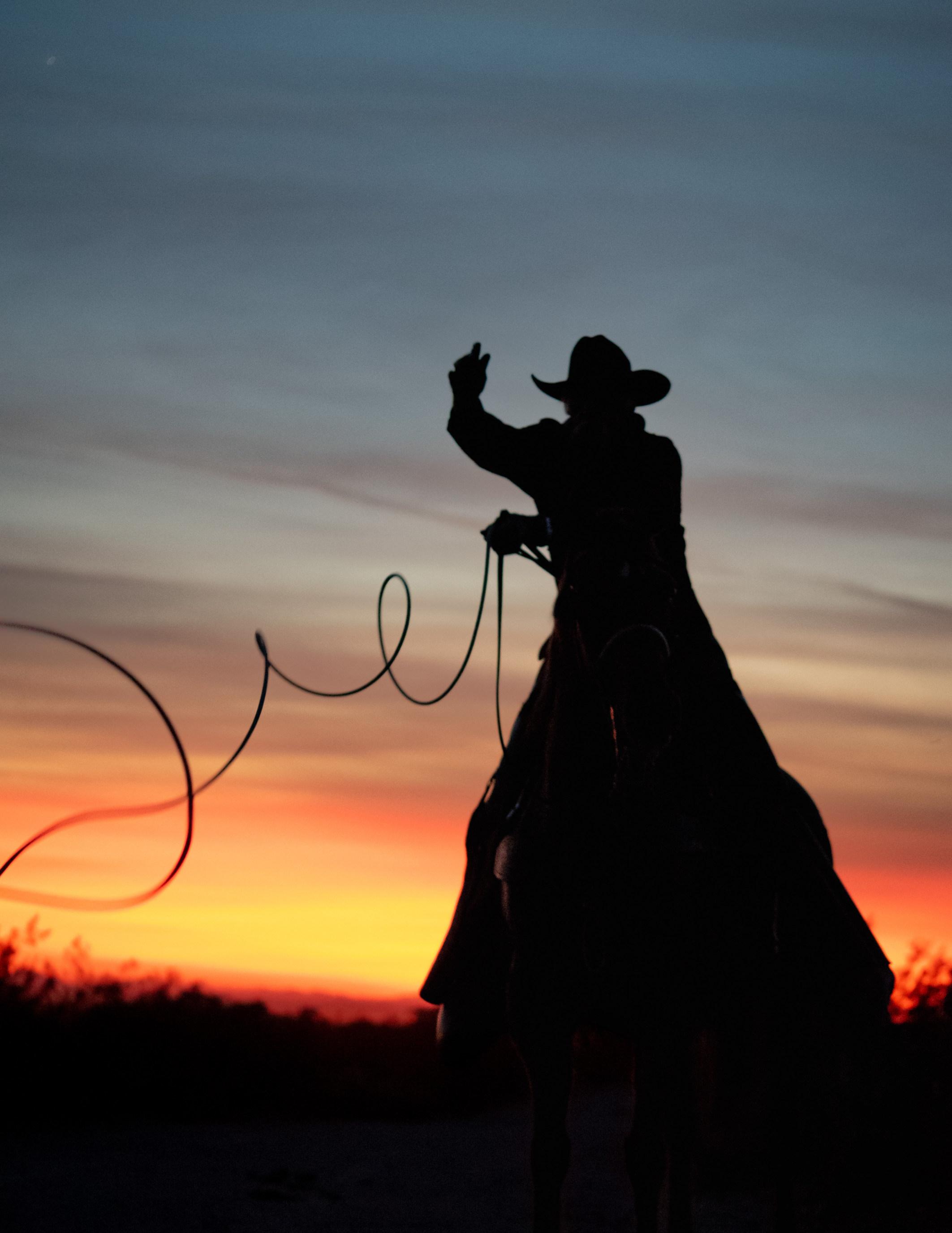
The Magic of Cowboys
January/February 2023
Chair
Programs
Treasurer
Membership
Editor
Communications
Meetup
Outings Outings


January/February 2023
Chair
Programs
Treasurer
Membership
Editor
Communications
Meetup
Outings Outings
Joe Doherty
Susan Manley
Ed Ogawa
Joan Schipper
Joe Doherty
Velda Ruddock
Ed Ogawa
Joan Schipper
Joan Schipper
Alison Boyle
joedohertyphotography@gmail.com
SSNManley@yahoo.com
Ed5ogawa@angeles.sierraclub.org
JoanSchipper@ix.netcom.com
joedohertyphotography@gmail.com
Vruddock.sccc@gmail.com
Ed5ogawa@angeles.sierraclub.org
JoanSchipper@ix.netcom.com
JoanSchipper@ix.netcom.com
AlisoniBoyle@icloud.com
Focal Points Magazine is a publication of the Sierra Club Camera Committee, Angeles Chapter. The Camera Committee is an activity group within the Angeles Chapter, which we support through the medium of photography. Our goal is to show the natural beauty of our world, as well as areas of conservation concerns and social justice. We do this through sharing and promoting our photography and by helping and inspiring our members through presentations, demonstration, discussion, and outings.
For information about membership and/or to contribute to the magazine, please contact the editors or the membership chair listed above. Membership dues are $15 per year, and checks (payable to SCCC) can be mailed to: SCCC-Joan Schipper, 6100 Cashio Street, Los Angeles, CA 90035.
The magazine is published every other month. A call for submissions will be made one-month in advance via email, although submissions and proposals are welcome at any time. Member photographs should be resized to 3300 pixels on the long side (if vertical) or 2550 pixels on the long side (if horizontal) for the highest quality layouts. They should also be jpg, in the sRGB colorspace.
Cover articles and features should be between 1000-2000 words, with 4-10 accompanying photographs. Reviews of shows, workshops, books, etc., should be between 500-1500 words.
Copyright: All photographs and writings in this magazine are owned by the photographers and writers who created them. They hold the copyrights and control all rights of reproduction and use. If you desire to license one, or to have a print made, contact the editor at joedohertyphotography@gmail.com, who will pass on your request, or see the author’s contact information in the Contributors section at the back of this issue.
https://angeles.sierraclub.org/camera_committee
https://www.instagram.com/sccameracommittee/
January/February 2023

4 The Magic of Cowboys
A Covid-era Zoom presentation by photographer Lisa Langell led four SCCC members to an in-person workshop at a working ranch outside of Phoenix. By John Nilsson and Velda Ruddock
COLUMNS
10 Shoot the Dunes
Sand dunes are the subject of many great landscape photographs. This column offers advice on how and when to shoot, plus some tips on surviving with your gear intact. By Joe Doherty
When I became the Chair of the SCCC twelve months ago I was filling a big pair of shoes. John Nilsson navigated us through declining membership, through the transition to bi-monthly meetings in a new location, and through COVID. He kept us active during lockdown using a new and untested technology called Zoom, an effective strategy that is going to continue to be the primary venue for our speaker series. This issue’s cover story is a direct consequence of one Zoom meeting.
John has now stepped down from his last job with SCCC, as the publisher and editor of Focal Points Magazine. During his tenure he turned a newsletter into a magazine, encouraged members to contribute their highest quality work, and wrangled a cover story for every issue. It was a lot more work than most people realize, and he deserves our great thanks for keeping us informed and entertained.
With this issue we’re building on what John started, and also changing some things. The biggest change is that we’re splitting the SCCC communication strategy into two branches: news and events, and photography.
News and events will now be sent to you twice a month via e-mail. If you have a show, a book, a calendar, a presentation, or any other event you would like fellow members to know about, send it to me (joedohertyphotography@gmail.com) and it will be in the next newsletter.
The primary purpose of Focal Points Magazine will be to show off your photography in as glossy a style as possible. It will come out six times a year, and it is sporting a new look to showcase the work of our members and authors. Please look through this issue and let me know what you think of it.
–Joe Doherty
February 9, 2023 at 7:00 pm PST


Alyce Bender is a nature photographer, writer, educator, and adventurer. Camera in hand since childhood, her fascination for photography developed into a career after serving in the U.S. Air Force. Her passion for wildlife and the natural environment compels her to connect others with nature through sharing both visual art and in-field experiences that promote conservation, creativity, and ethical photography.
She is a Tamron USA Ambassador, contributing writer and photographer for the Journal of Wildlife Photography, and her work has been featured in group and solo gallery shows across the US as well as in international publications from the UK to Japan. Bender leads photography adventures around the world to help beginner through advanced photographers explore and expand their personal vision and naturalist skills ethically. When not in the field, she offers a variety of educational programs both in person and virtually for photography organizations large and small.
Please register for Alyce Bender’s talk in order to get a link to participate. Registration is Zoombomber repellent.
https://us02web.zoom.us/meeting/register/tZEuce-urDktHNG24FBNy4lESO2-BIfUFr3W

A Covid-era Zoom presentation by photographer Lisa Langell leads four SCCC members to a weekend in Arizona, where they photographed cowboys and cowgirls on a working ranch.
By John Nilsson and Velda Ruddock

The idea came together over a year ago (October 14, 2021) during the dark days of the Covid Lock Down. Lisa Langell, of Lisa Langell Photography, provided a compelling presentation about her photography teachingand-outing business to the Sierra Club Camera Committee (SCCC) membership over Zoom. During the presentation she announced a three-day workshop in Phoenix on the Don Donnelly Ranch at Superstition Mountain. The goal of the workshop was to offer an opportunity to photograph a real working ranch, its inhabitants and operations, and to learn techniques and settings to accomplish this task.
We waited a day and then applied, discovering that both sessions were already sold out! So we jumped at the opportunity to get into the
2023 session! John Nilsson, and long-time friend and fellow SCCC member, Basil Katsaros, traveled together, as did husband and wife team, Joe Doherty and Velda Ruddock. The four of us were an enthusiastic block of the attendees.
We arrived at the ranch on Friday, January 13th , for the 2:00 kickoff and orientation. Lisa reviewed the revised itinerary and best settings for the upcoming workshop. She introduced us to the ranch cowboy/cowgirl photographic models and a robust staff who would work with us the rest of the workshop. Although there were more participants than in most workshops, we always had access to assistance, and because we broke up into smaller groups, we never once felt like we were not seen, heard, or helped.
The third day of the workshop, Sunday, was expected to be very rainy so Lisa packed more events into Friday and Saturday than originally planned. The sessions included portraiture, action, silhouettes, reenactments and demonstrations, some processing tips, and as a bonus, a performance by songwriter, Steve Holmquist. Friday and Saturday we were treated to great catered chuckwagon dinners provided by Barb Kennedy of Cowgirls Forever. This workshop did not go halfway!
After orientation on Friday we warmed up with posing and photographing our ranchhand models and their horses. After that it was off to the ranch entrance road for evening work and some backlit/silhouette photography. Breezy conditions and lots of atmospheric dust and beautiful cloud cover of an approaching storm resulted in a colorful stage for the great horsemanship of our cowboys and cowgirls.

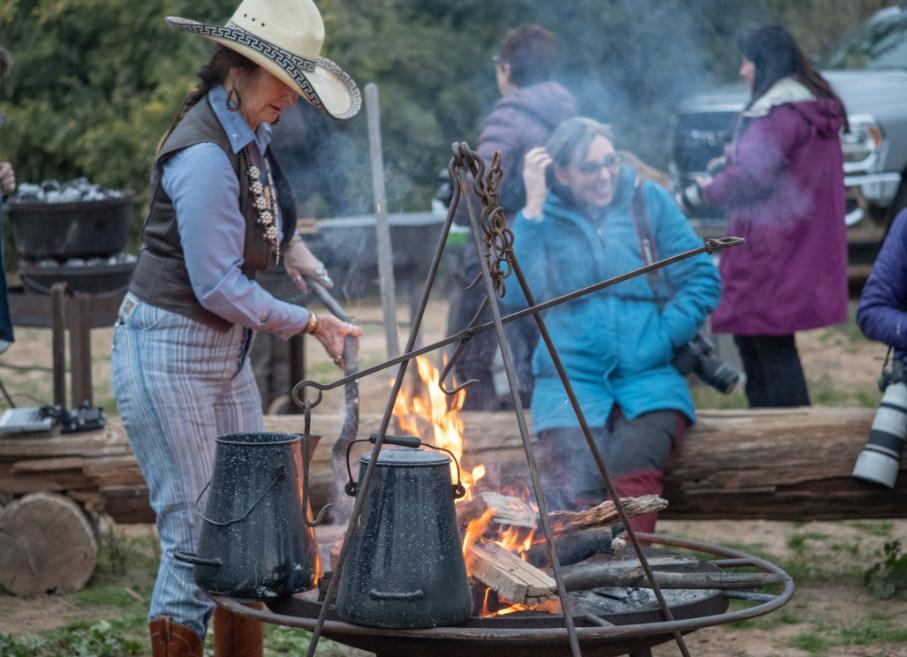
When it got darker we focused on silhouettes. We were treated to an absolutely magnificent sunset and as a result our photos were dramatic.
After photographing almost non-stop for four hours it was dark and time to enjoy a dinner under the stars.
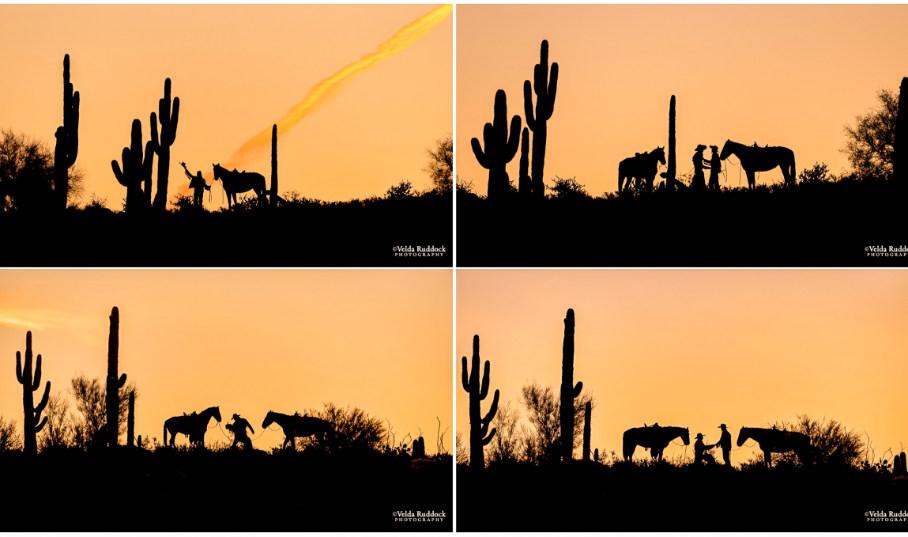
Saturday morning dawned clear and warm. We were treated to photographing ranch-hand silhouettes on a far cactus covered hillside in the early morning light. The models, Mike and Lexa already had a romantic relationship and hammed it up to our great delight.
When silhouettes were no longer an option we transitioned to arena activities where we photographed the horses running. These were great action shots!

After a quick break, Lisa, with the assistance of two professional portrait photographers, Mary Mannix and Lori Figueroa, introduced us to the elements of portraiture. Their presentations were well-organized and full of information on settings, how to pose your model, and attention to natural lighting. She then introduced us to a lively group of western “reenactors” who brought a depth to our sessions we otherwise would not have had.

During the portraiture and reenactment shoots we went from station to station to photograph various scenarios. Several cowboys and cowgirls and the entire troupe of reenactors provided subjects for this shoot which was an interesting mix of street, scenic, and portraiture photography. We were expected to pose our models, something more difficult than we expected but therefore also more rewarding.

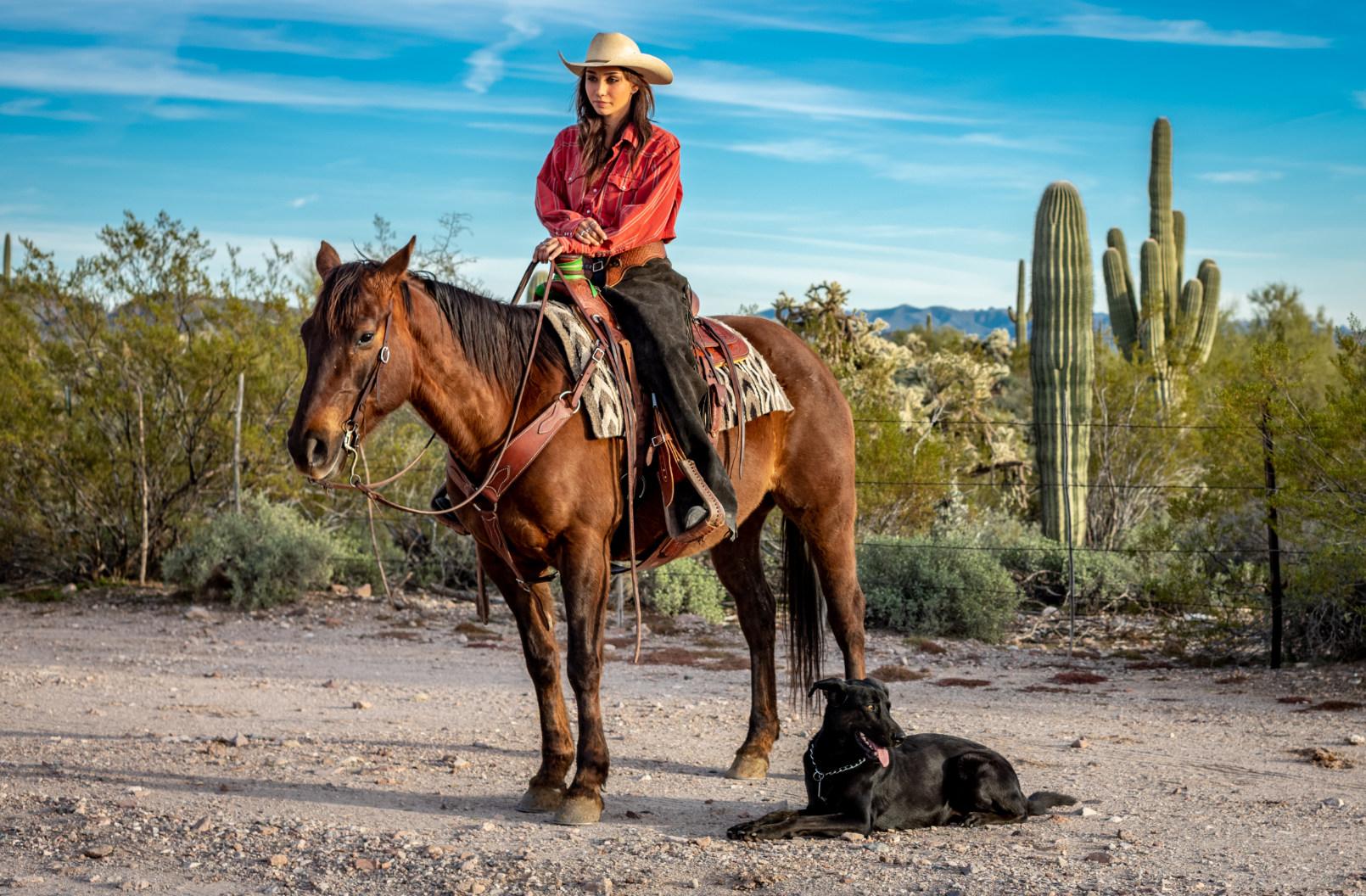
Next we had action shots of various ranch scenes which included a home-built wagon. We practiced capturing [or trying to capture] gun flare. A highlight of the afternoon was presented by Andella Parten who is a champion multitalented rider. She treated us to an amazing show in which she shot balloon targets with her pistols at full gallop. For us, the challenge was to capture the flare from the gun, the balloon exploding, and the drama of this show champion. Andella’s horse only had two speeds – a walk/trot and flat-out racing –and we kept our finger on the shutter button for each pass. Both gunfire shoots amounted to a lot of images – most of which we could throw away later. As an FYI, while the reenactment actors used quarter-round blanks. Andella used gunpowder.
The following and last morning was greeted by significant rain as expected. Lisa had anticipated this event and rented a meeting hall where we discussed various camera and photo finishing techniques. We had the
advantage of being instructed by Lisa and highly experienced commercial photographers Mary and Lori who shared their experience with Photoshop, Lightroom and Photo Mechanic. The experience was capped by lifetime area resident Steve Holmquist who sang and played many of his original story/songs about the history of the immediate area around the Superstition Mountains.
The last event, before goodbyes was a roundup demonstration of a herd of Longhorn Cattle driven by the cowboys and cowgirls in and out of their pens and back onto the desert range behind the main ranch. All three ranchhands lassoed some of the cattle and brought them down safely. This is potentially a dangerous activity, especially on the wet ground, but an experienced cowboy explained of how this was done safely and responsibly.
We highly recommend this outstanding workshop and any other workshop offered by Lisa Langell. Her attention to detail and
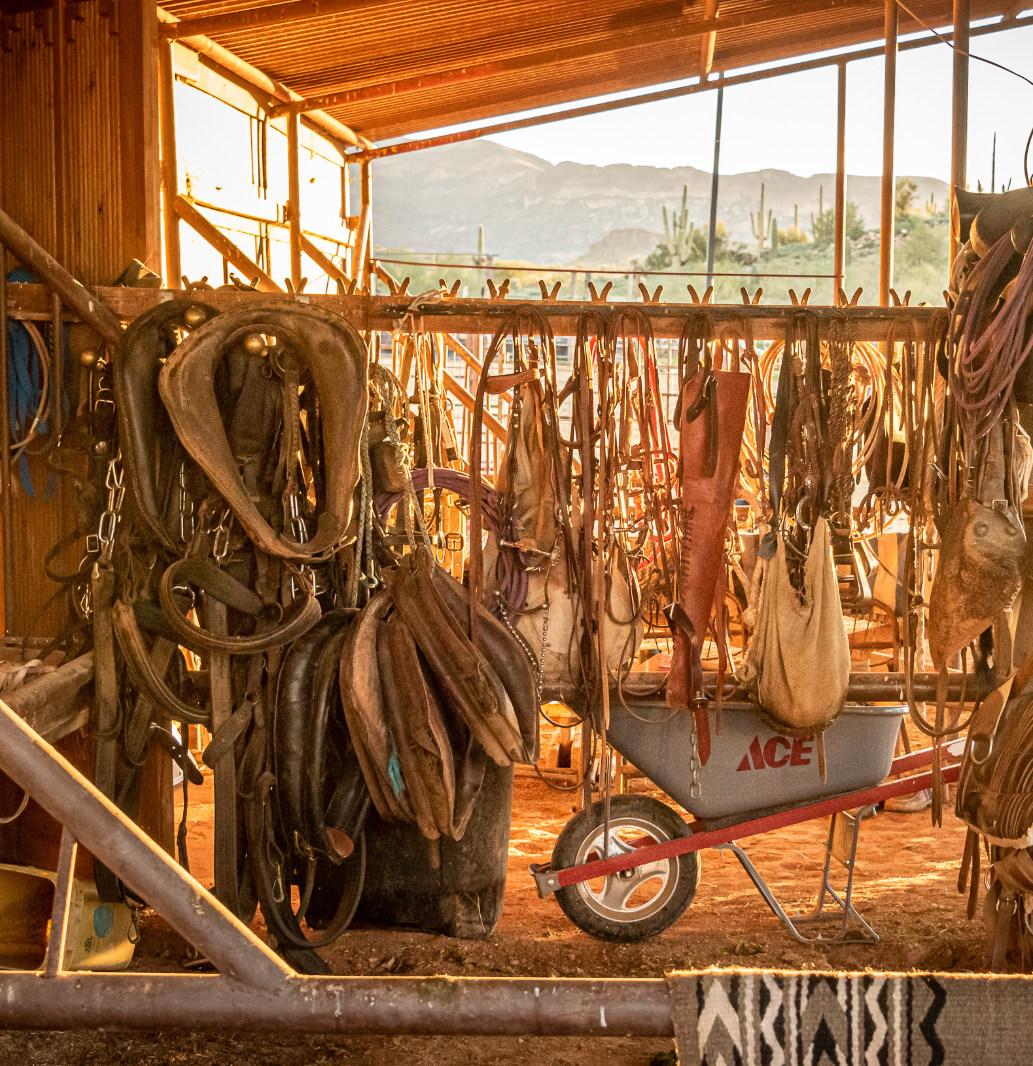
planning was exceptional. Specific recommendations for gear and photographing was provided for each event and instruction for specific types of photography was given with the assistance of her team. All in all it was a great experience.
Lisa Langell Photography
https://langellphotography.com/ Mary Mannix Photography
https://www.marymannixphotography.com/ Lori Figueroa Photography
https://lpro.smugmug.com
Steve Holmquist (singer)
https://music.apple.com/us/artist/steveholmquist/1136955915
Barb Kennedy of Cowgirls Forever https://cowgirlsforever.net/ Donnelly D-Spur Ranch http://www.dondonnellyd-spur.com/

By Joe Doherty
I’ve photographed dunes in many places –Death Valley, White Sands, Oceano, Sand Mountain, Kelso, Oostduinen – and I almost always get it wrong. More specifically, I almost always fail to achieve what I set out to achieve. Like many of you I am steeped in the dune images of Edward Weston and Ansel Adams and David Muench, of National Geographic, and of David Lean’s “Lawrence of Arabia.” Dunes are pristine places, with ripples and lines and shadows, and towering shapes of monumental proportion.
I almost never get those images. I’ve found that those scenes are as ephemeral as red aspen leaves at North Lake, and as well-visited. To capture the iconic images, and to extend them a bit, requires some planning, some flexibility, and some luck. This column offers some advice on how to increase the probability of success when


you decide to shoot the dunes, once you’ve identified the dunes you wish to photograph.
Watch the weather. Some landscape photographs are better when the photographer is uncomfortable. Dunes are no exception. Classic photographs of sand dunes have few or no footprints. They have sharp edges at the top of each ridge, and have well-defined textures on the sides. These features are caused by a strong wind blowing consistently from one direction, such as the winds that accompanied the atmospheric river that recently hit California. It isn’t necessary to stand in the sandstorm to capture the images, but it helps if you are very near the dunes when they happen, so you can be outside with your camera when they quiet down.
If there are footprints, try to incorporate them into the story (as a leading line between dunes, for example) or look for places where people can’t walk. Some dunes are so steep that it’s impossible to walk across them. The corollary to all of this is, don’t walk through your composition. If you are blessed with pristine dunes, be very strategic about where you step. Stay off the ridges and in the shadows. Your fellow photographers will thank you.
Shoot early or late. This is common advice given to landscape photographers. The blue

hour, the golden hour, alpenglow, “the time when autofocus doesn’t work,” all happen on the cusps of the day. Shooting in the flat light before sunrise or after sunset accentuates the contours of dunes. Depending on the color of the sky it can also make for an interesting palette, with dark blue shadows and magenta or golden highlights. The light changes as the sun kisses the horizon, rising or setting. It subtly strikes the dunes and accentuates their texture, creating contrast between the light and dark side of ridges, and rapidly changing the character of the landscape. This is a moment when it’s best to be in a position to shoot what is in front of you, since it does not last very long and you will not have much time to explore.
The landscape is transformed again when the sun is fully above the horizon but still low in the sky. This period of time will last the longest during the month before and after the Winter Solstice. That is also the time of the year when weather is more likely to transform the
landscape. At this point in the day, whether in the morning or late afternoon, you have the leisure of roaming around looking for leading lines, shadows, and textures. It’s also a good time to hunt for compositions that you might

want to shoot when the light changes, so you can be in position at the decisive moment.
Don’t change lenses in the field. It is a bad idea to open your camera body when surrounded by blowing sand. Even if it seems quite calm, don’t do it. Trust me. Plan ahead so that you have the equipment you need to realize the images you want to capture. If you want the greatest variety with one lens, something like a 28-300 is a good choice, with a protective filter on the front (skylight or UV). Carrying two cameras, one with wide-angle zoom and another with a telephoto zoom, is also a good option, if you can swing it. A smartphone with a good camera substitutes for the wide-angle zoom. Or you can commit to one perspective, wide-angle or telephoto, and carry just that lens on one body. Such constraints can be a spur to creativity by narrowing the available options.
Isolate shapes and juxtapose textures. Sand dunes are defined by the shape of their curves
and the texture of their surfaces. I have heard that these are so distinctive that some people can identify the location of a dune without any further information. Take advantage of this. Use the characteristics of the sand to express yourself by composing images that emphasize the most dramatic or unique features of the dunes at your location. Contrast ripples with smooth sand, or sharp ridges against soft curves.
Vary your aspect ratios. We tend to shoot first and crop later. It is easy to get settled into the standard full-frame ratio of 2:3 (from 35mm film days). Leading lines are dramatic in that ratio, and it’s a format that lends itself to dramatic near/far compositions. If we only shoot in that ratio, however, the others (like 1:1 and 4:5) become an afterthought, a kind of post-processing rescue. I suggest that you intentionally crop in-camera at these other ratios. Each of them has their own constraints, and their own dynamic power, and seeing the

dunes in those terms can change how you relate to them.
Process for feeling, not representation. In landscape photography there is a tension between making an accurate representation of a scene and using the scene to convey an emotion or a thought. With sand dunes it’s easy to resolve that tension in favor of being emotional and thought-provoking. The aggressive use of color, contrast, and sharpness (by addition and subtraction) is more acceptable when there are no reference points like ridges, rivers, or roadways. It’s a perfect opportunity to experiment.
Don’t get lost! Sand dunes are disorienting. There may be no trails, no obvious landmarks, and no signal. Getting lost, or finding your way back only to realize that your shooting partner is lost, is a possibility. To avoid this nightmare I use two strategies to get back to my car. The first is to download the Google map for the area
I plan to explore while I still have connectivity. I drop a placemarker at my location when I park the car, and then use gps to get back to the placemarker. This worked well in White Sands, where the parking areas are within the dunes themselves. The second strategy is to regularly climb high points and orient yourself to distant landmarks. Perhaps take a photo at each place, so you can work your way back visually if needed. And bring enough water.
Finally, keep in mind that this is not a competition. All of the images of sand dunes that you have ever seen will obviously influence your approach. But to influence is not the same as to dictate. Use your knowledge and your emotional response to the work of others to inform what you are doing, but don’t try to copy it. You can’t copy it. The light, the location, the season, and the sand all make reproduction virtually impossible.
www.joedohertyphotography.com
Photos and text © Joe Doherty

All photos © Larry Miller
Red Rock Canyon is one of the gems of the California State Park system. Yet its colorful desert badlands attract few visitors, who are deterred by intense summer heat, a paucity of good maps, and a lack of trail signage. I captured these images on a November day trip without venturing more than a mile from the park’s visitors center.




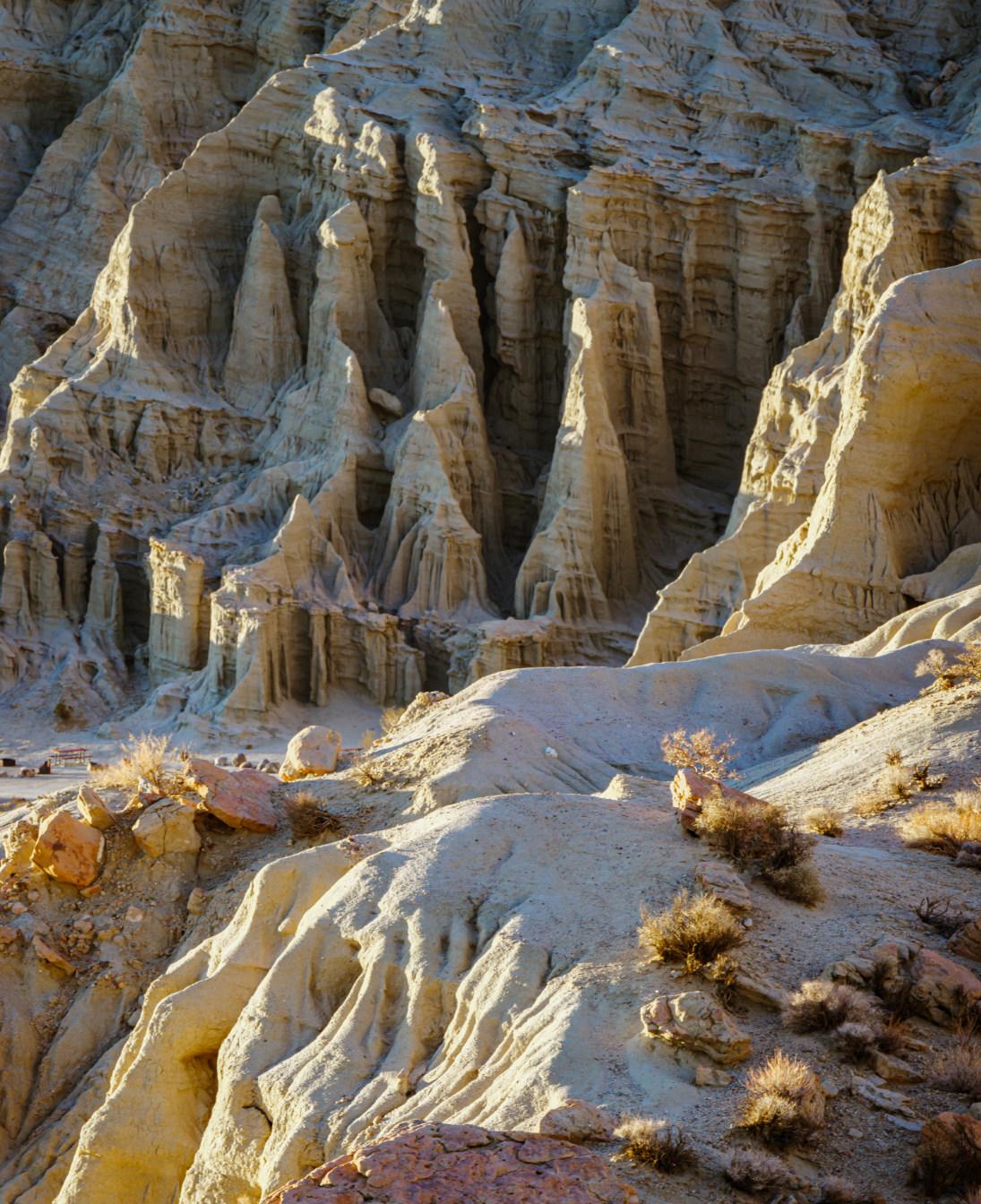


All photos © Joe Doherty
We try to spend most of January on the road, capturing the American West in its dormant and snow-capped glory. In past years we’ve visited Yellowstone, Owens Valley, and the vast open spaces of central Nevada and US 50.
This year we spent some time in California,Arizona and Utah. The weather chased us out of Yosemite Valley after one night, and after re-supplying our camper we headed east. Two places in particular called to us. Navajo National Monument in Northeast Arizona is an isolated and beautiful spot between Tuba City and Kayenta. It contains beautiful red rock formations, and an alcove that protects a cliff dwelling settlement.

Joe Doherty
All Photos © Joe Doherty
We also spent three nights in Monument Valley. Fresh snow fell during our first night, and we awoke to a white-out of fog and falling flakes. By late afternoon it cleared a little bit, and we caught brief glimpses of the landmark mittens and other iconic rock formations. On our last full day we hired a guide, Ray Begay, who took us deep into the park.

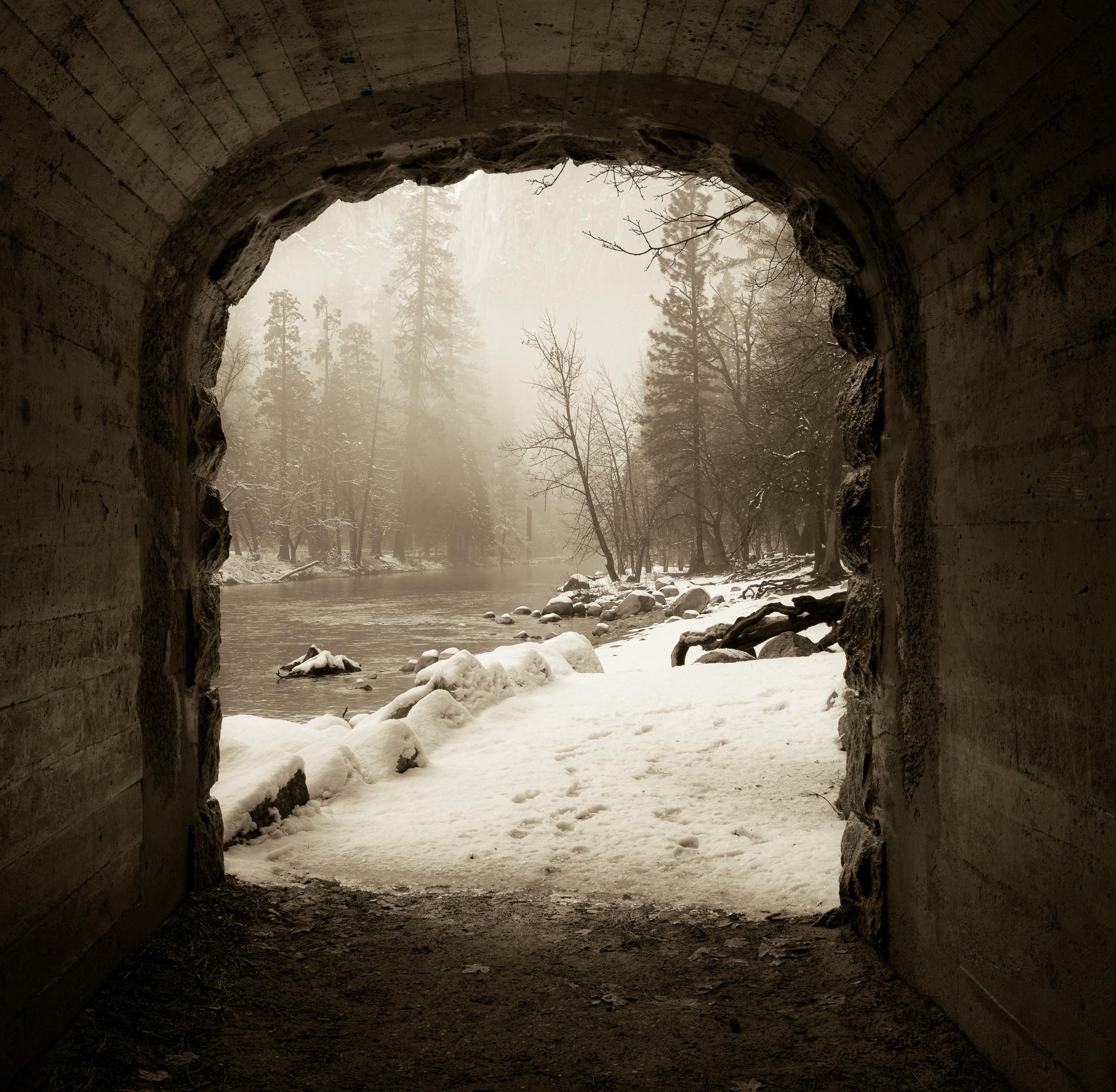

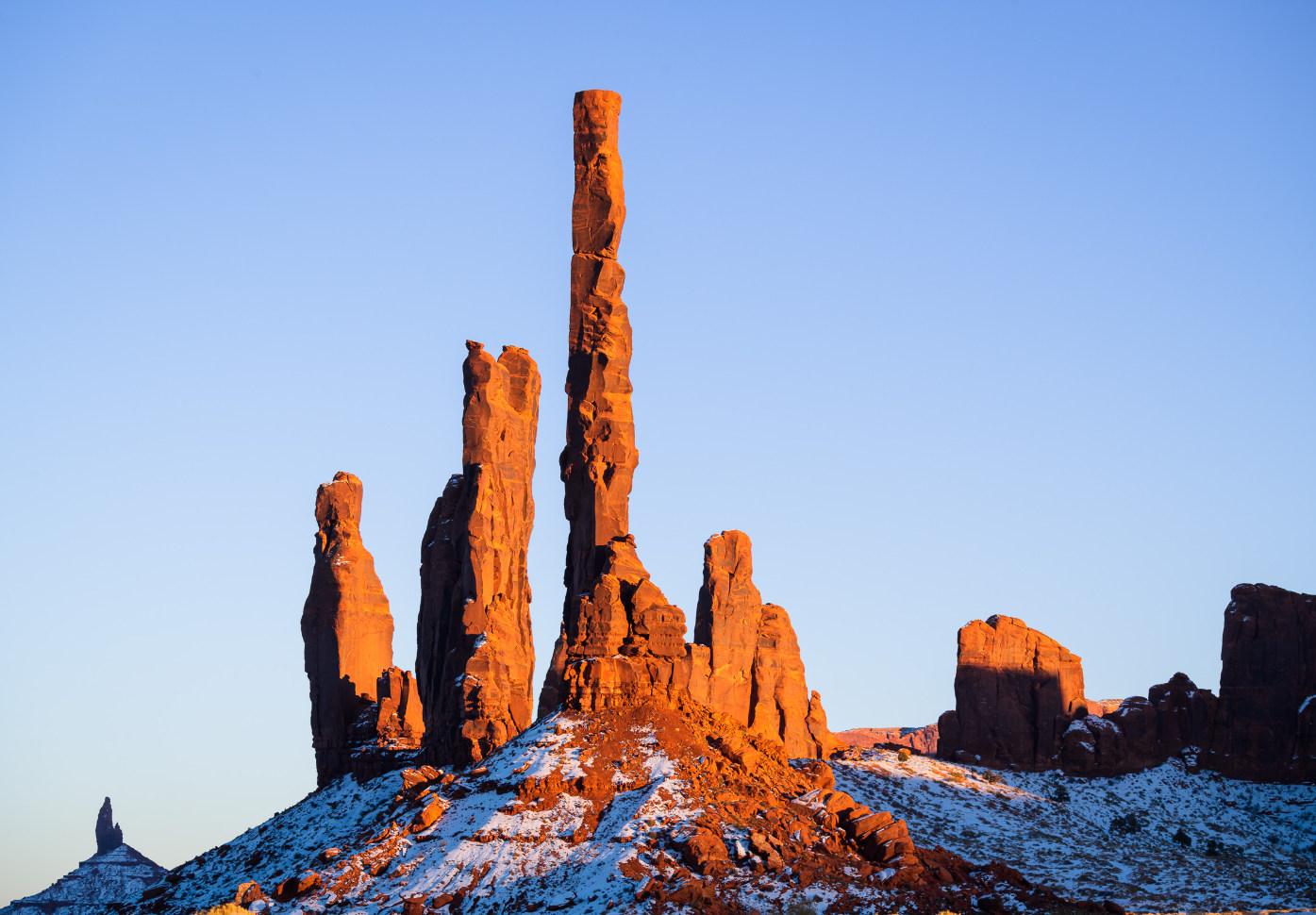
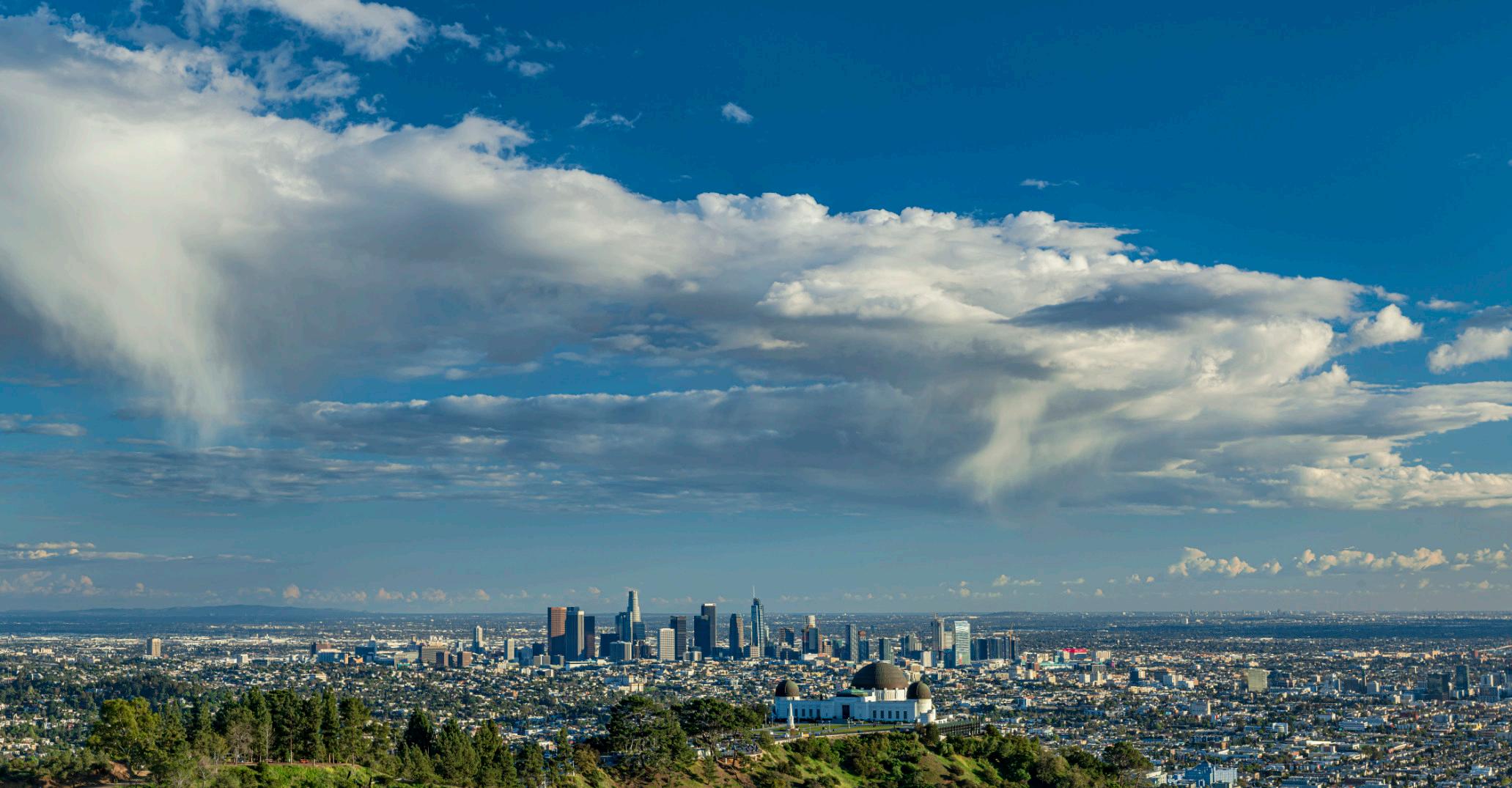



Four photos taken from Griffith Park in February 2022 as a storm was clearing out of the area, providing crystal clear views out to Catalina Island.

Moon Furrows. The skies cleared overnight and the full Wolf Moon was setting. I had an image in mind with an old farm I’ve been visiting for years. On the back road in, the setting Moon in the alpenglow sky and the snowy furrows caught my eye. A quick stop and a few shots and I was on my way.
All photos © John Clement
Divine Lines. Country Bible Church was near my location when these rows of cirrus clouds moved in. I knew immediately what I wanted to capture after a short ten-minute drive in the winter Palouse.

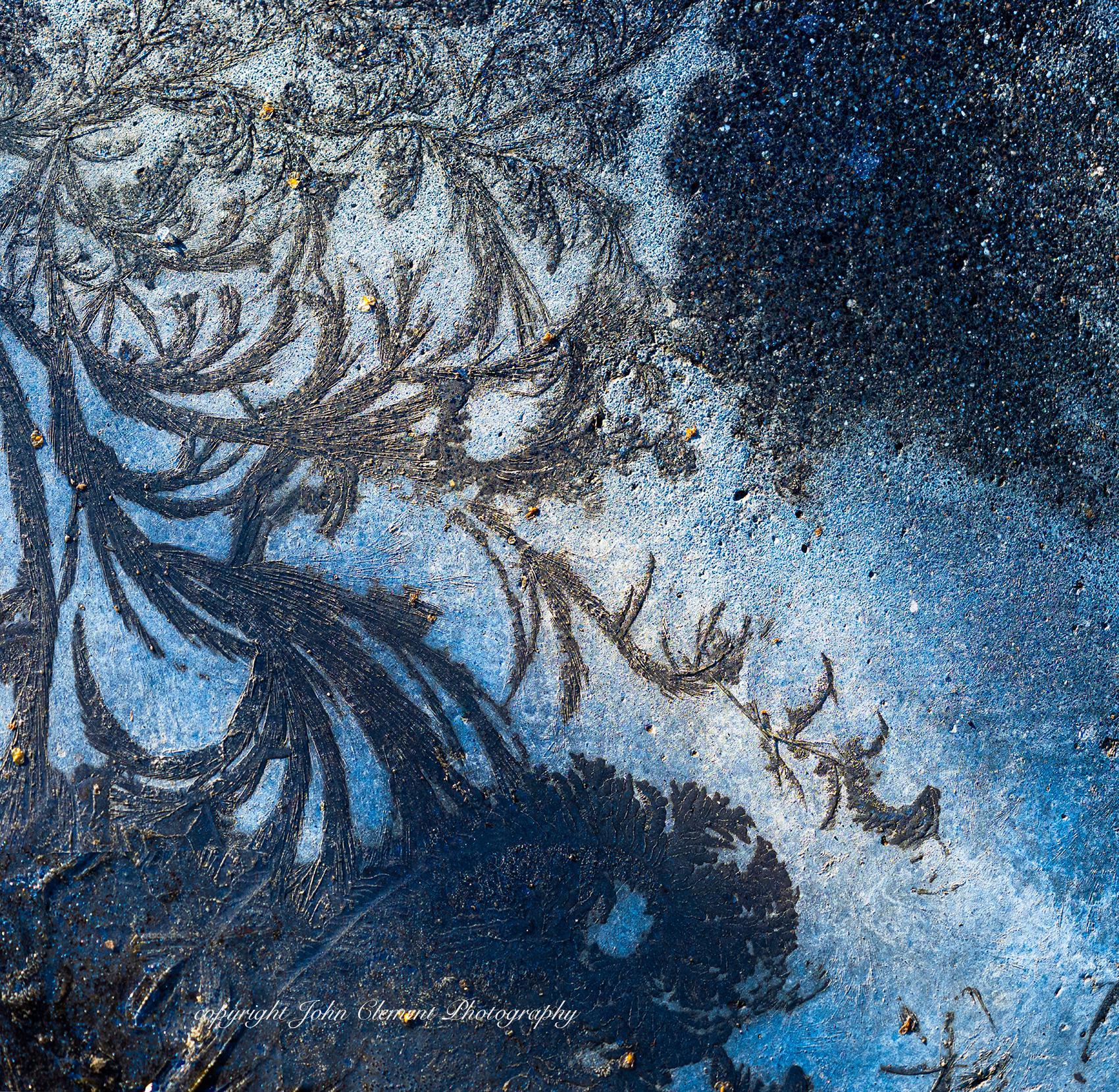
Driveway Art 1. Heading out the front door to deliver some art work to a gallery, I was quickly sidetracked by the frozen ice/frost patterns on my driveway and car. I went back for the camera to capture a few images, which turned into 45 minutes of wonderful frosty captures all around the yard in the early morning sunlight.

Enwrapped in Winter. In the NE Palouse several years ago I made a 2-day drive into areas where I hadn’t spent much time during the winter, and was rewarded with some wonderful images.


Focal Points Magazine January/February 2023

All photos © John Clement
Frosty Stingers. From the dried sunflower portion of my wildflower garden. I left a section of the garden just for this purpose of making winter images.

Heaven’s Porthole. Returning from a winter seminar that I was leading in the Hood River Valley, the heavy overcast started to open up. I was about five miles from this location but I knew immediately the image I wanted over this old deserted homestead. Knowing where things are when the light is happening can help you capture some wonderful images.
All photos © Thomas Cloutier


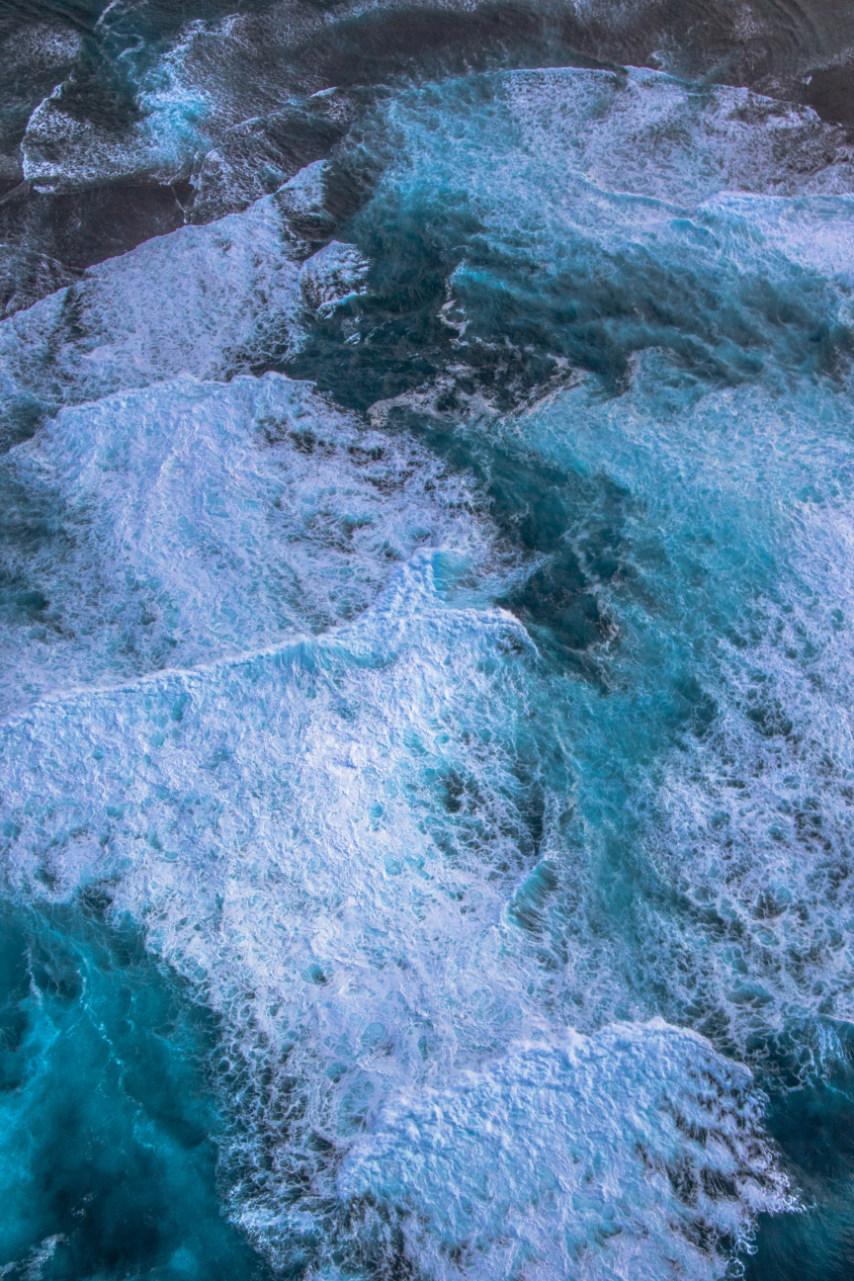

All photos © Velda Ruddock






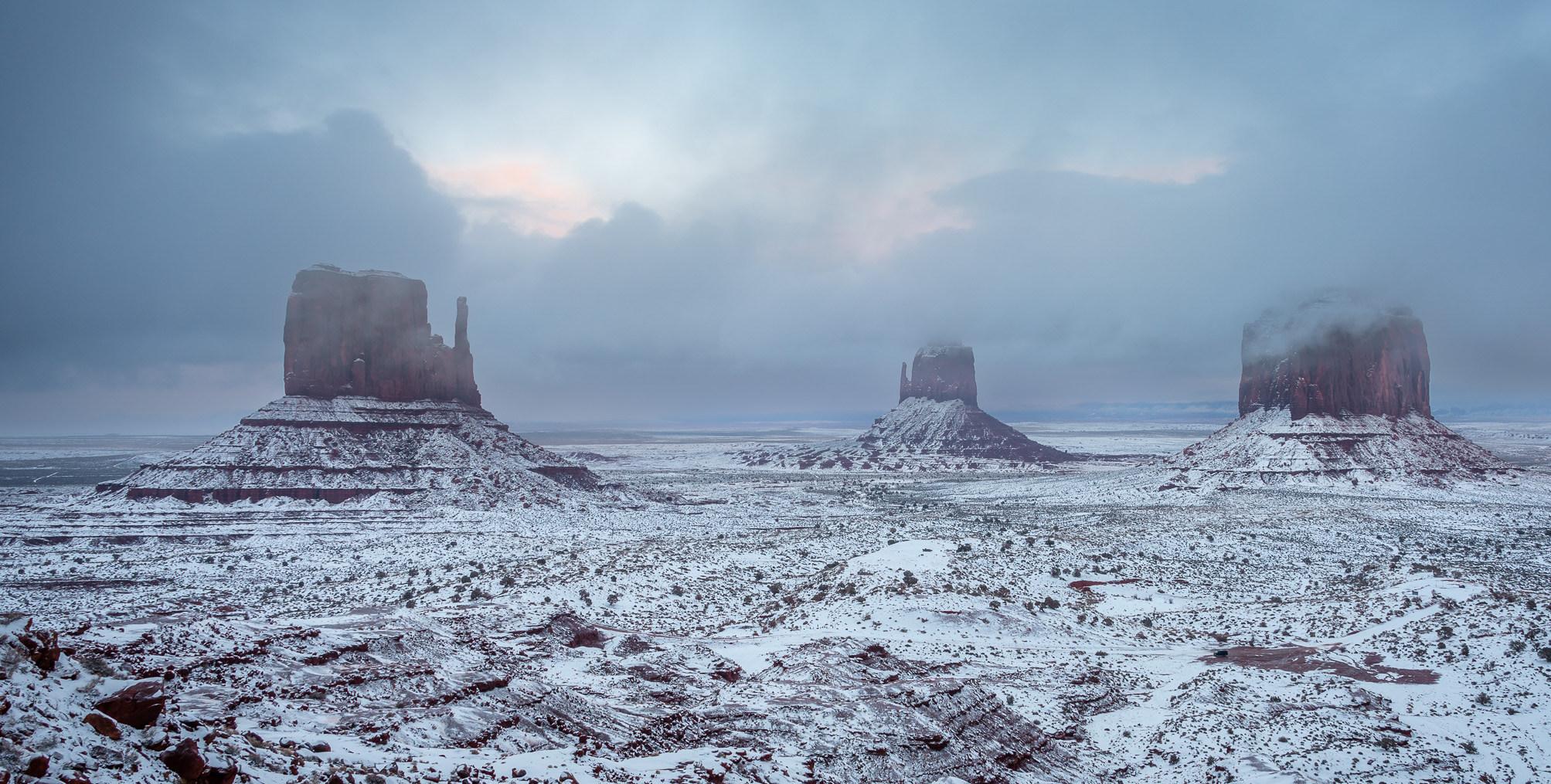
Monument Valley after the snow. The part everyone knows (above), and the part only guides show you (below).







John Clemment began his career in photography in the early 70’s after graduating from Central Washington University with a double major in Geology and Geography. Since then he has earned a Masters of Photography from the Professional Photographers of America. He has received over 65 regional, national and international awards for his pictorial and commercial work. His photographs grace the walls of many businesses in the Northwest and has been published in numerous calendars and coffee table books.
Clement has provided photographs for Country Music Magazine and Northwest Travel Magazine. He has supplied murals for the Seattle Seahawks Stadium and images for The Carousel of Dreams in Kennewick, WA.
Current projects include 17 – 4x8 foot glass panels featuring his landscapes in Eastern Washington for the Pasco Airport Remodel. Last year he finished a major project for the Othello Medical Clinic where almost 200 images were used to decorate the facilities.
www.johnclementgallery.com
John Clement Photography (Face Book)Allied Arts Gallery in Richland, WA.
Thomas Cloutier has been with SCCC since 2001, and he has been contributing to Focal Points Magazine since that time.
Cloutier’s interest in photography coincides with his interest in travel and giving representation to nature landscapes. His formal education in photography comes from CSU Long Beach.
At present Cloutier is a volunteer at CSU, Long Beach where he taught Water Colors and Drawing at the Osher Lifelong Learning Institute (OLLI), designed for Seniors over 45. He also is a docent at Kleefield Contemporary Museum CSU Long Beach. He is Liaison for the Art And Design Departments for a scholarship program for students at CSU Long Beach, Fine Arts Affiliates, FineArtsAffiliates. org.
Cloutier at cde45@verizon.net
Joe Doherty grew up in Los Angeles and developed his first roll of film in 1972. He has been a visual communicator ever since.
Doherty spent his teens and twenties working in photography, most of it behind a camera as a freelance editorial shooter.
He switched careers when his son was born, earning a PhD in political science from UCLA, specializing in American politics and research methods. This led to an opportunity to run a research center and teach at UCLA Law, where he became best known as an empirical bankruptcy scholar.
After retiring from UCLA in 2016 Doherty continued to consult, but now he and his wife, Velda Ruddock, spend much of their time in the field, across the West, capturing the landscape. www.joedohertyphotography.com
As a youth, John Fisanotti’s interest in photography stemmed from an interest in astronomy. His first photos were attempts to photograph the night sky using a folding Kodak camera, that once belonged to an uncle. Later, he used a 35mm rangefinder camera to photograph nature, particularly the San Gabriel Mountains above his home in La Crescenta. After high school, Fisanotti sold his telescope to purchase a 35mm SLR camera outfit.
Fisanotti was a photography major in his first three years of college. He has used 35mm, 2-1/4 medium format and 4x5 view cameras. Expecting to be a commercial photographer, his personal work leaned heavily to shooting landscapes and outdoors.
In 1977 Fisanotti changed majors. After graduating from CSU, Los Angeles, with a Bachelor of Arts Degree in Urban Studies in 1979, his first post-college job was in a commercial photo laboratory.
In 1980, Fisanotti pivoted from photography and began his 32-year career in public service. John worked for four Southern California cities in city planning, community development and redevelopment, and concluded his career as a Project Manager for the Culver City Redevelopment Agency. During these decades, he continued to shoot outdoor scenic images whenever possible.
After retiring from public service in 2012, Fisanotti has pursued his astronomical and photographic interests. Beginning in 2013, John has been a telescope operator for the 60" reflector telescope at Mt. Wilson Observatory. He increased his photographic portfolio - concentrating on outdoors, landscape, travel and astronomical images. Beginning in 2018, he expanded his repertoire to include architectural and real estate photography.
Occasionally, Fisanotti has been fortunate to have photographs selected for various exhibitions or publications. He currently shoots with Nikon DSLR cameras.
http://www.johnfisanottiphotography.com and http://www.architecturalphotosbyfisanotti.com jfisanotti@sbcglobal.net or fisanottifotos@gmail.com
Larry Miller bought his first SLR camera in 1985 to document hikes in the local mountains. In fact, his first Sierra Club Camera Committee outing was a wildflower photo shoot in the Santa Monica Mountains led by Steve Cohen in 1991. Since then the SCCC has introduced him to many other scenic destinations, including the Antelope Valley California Poppy Reserve, the Gorman hills, and Saddleback Butte State Park.
Miller’s own photography trips gradually expanded in scope over the years to include most of the western National Parks and National Monuments, with the Colorado Plateau becoming a personal favorite.
Photography took a backseat to Miller’s career during the 32+ years that he worked as a radar systems engineer at Hughes Aircraft/Raytheon Company.
Since retiring in 2013, he has been able to devote more time to developing his photographic skills. Experiencing and sharing the beauty of nature continues to be Miller’s primary motivation. lemiller49@gmail.com
John Nilsson has a fond memory of his father dragging him to the Denver Museum of Natural History on a winter Sunday afternoon. His father had just purchased a Bosely 35mm camera and had decided he desperately wanted to photograph one of the dioramas of several Seal Lions in a beautiful blue half-light of the Arctic winter.
The photo required a tricky long exposure and the transparency his father showed him several weeks later was spectacular and mysterious to Nilsson’s young eyes. Although the demands of Medical School made this photo one of the first and last Nilsson’s Dad shot, at five years old the son was hooked.
The arrival of the digital age brought photography back to Nilsson as a conscious endeavor - first as a pastime enjoyed with friends who were also afflicted, and then as a practitioner of real estate and architectural photography during his 40 years as a real estate broker.
Since retiring and moving to Los Angeles, Nilsson continued his hobby as a nature and landscape photographer through active membership in the Sierra Club Angeles Chapter Camera Committee, as well as his vocation as a real estate photographer through his company Oz Images LA. The camera is now a tool for adventure!
www.OzImagesLA.com
Creativity has always been important to Velda Ruddock. She received her first Brownie camera for her twelfth birthday and can’t remember a time she’s been without a camera close at hand.
Ruddock studied social sciences and art, and later earned a Masters degree in Information and Library Science degree from San Jose State University. All of her jobs allowed her to be creative, entrepreneurial, and innovative. For the last 22 years of her research career she was Director of Intelligence for a global advertising and marketing agency. TBWA\Chiat\Day helped clients such as Apple, Nissan, Pepsi, Gatorade, Energizer, and many more, and she was considered a leader in my field.
During their time off, she and her husband, Joe Doherty, would travel, photographing family, events and locations. However, in 2011 they traveled to the Eastern Sierra for the fall colors, and although they didn’t realize it at the time, when the sun came up over Lake Sabrina, it was the start of changing their careers.
By 2016 Ruddock and Doherty had both left their “day jobs,” and started traveling – and shooting nature – big and small – extensively. Their four-wheel-drive popup camper allows them to go to areas a regular car can’t go and they were – and are – always looking for their next adventure.
www.veldaruddock.com VeldaRuddockPhotography@gmail.com

© John Nilsson